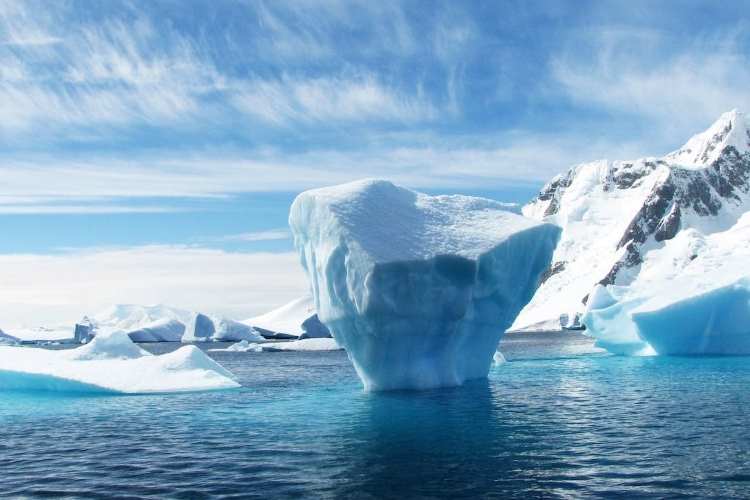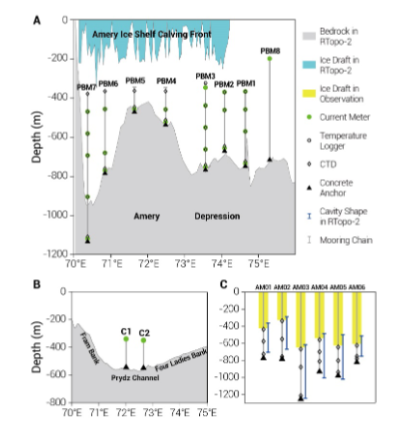
The Antarctic ice sheet is melting at an alarming rate, not solely because of the rise in atmospheric temperatures. A multi-institution research collaboration shows that tides may be playing a larger role in ice melt in Antarctica than previously thought. The study found that tidal currents from Prydz Bay may be responsible for nearly 69% of basal melting on the Amery Ice Shelf.
Previous studies have explored the influence of tides on the Amery Ice Shelf, but few direct observational data were available. Modelling efforts provided insights into tidal characteristics, but uncertainties remained due to limited validation. Tidal currents were particularly underrepresented in Prydz Bay compared to other Antarctic regions, making this study significant.
The study, conducted by a team of researchers from China, the United States, and Australia, sought to quantify tidal currents and their impact on basal melting in Prydz Bay. It utilised long-term mooring arrays deployed over the continental shelf. The observed tidal currents were analysed, and tidal heat transport and kinetic energy were assessed. The study also examined whether tidal currents could modify the ocean heat content of the AIS cavity and affect its basal melting rate.
READ I Climate finance: Charting the course for a sustainable future
The researchers documented the characteristics of observed tidal currents using data from mooring arrays. Mixed diurnal–semidiurnal tides were found in Prydz Bay. Tidal currents were weaker than those in other Antarctic regions, with an average magnitude of about 3 cm/s. However, localized areas exhibited stronger currents, such as the AIS front. Seasonal variability in tidal currents was noted.
Topographical features from RTopo-2 in Prydz Bay

Antarctica lost an average of 152 billion tonnes of ice per year between 2002 and 2021. This melting is having a number of negative consequences, including rising sea levels, more extreme weather events, and changes in ocean currents. The main cause of the melting of Antarctic ice is climate change.
The burning of fossil fuels releases greenhouse gases into the atmosphere, which trap heat and cause the earth’s temperature to rise. This warming is causing sea ice to melt at an accelerated rate. This phenomenon is a major threat to the environment and to human life. Rising sea levels are already inundating coastal communities, and more extreme weather events are causing widespread damage. Changes in ocean currents are disrupting marine ecosystems and affecting global food supplies.
Tidal waves and Antarctic ice melt
Tidal currents have several important effects on the Antarctic marine environment. They transport deep water onto the continental shelf, enhance the movement of dense shelf water over the continental slope, induce mixing, and impact water mass characteristics. Tidal currents influence Antarctic Bottom Water formation, sea ice production, and thermohaline circulation. Furthermore, tidal currents affect ice shelves, including pumping water into sub-ice-shelf cavities, amplifying turbulence, and impacting ice shelf stability.
The study quantified the contribution of tides to AIS basal melting using observational data and modelling results. A simple model estimated the tidal contribution to the melting rate. The results indicated that tidal currents play a significant role in AIS basal melting, potentially contributing up to 69% of the total melting rate. The analysis acknowledged uncertainties related to simulated velocity and temperature.
Schematic diagrams of hydrographic observations

The research contributes valuable observational data on tidal currents and their implications for AIS basal melting in Prydz Bay. The findings provide insights for future modelling efforts, including open boundary constraints and sensitivity experiments. The study’s results also underscore the importance of direct observations in enhancing our understanding of complex Antarctic ocean dynamics.
The study has addressed a critical gap in scientific knowledge on Antarctic ocean dynamics by investigating tidal currents and their intricate influence on the basal melting of the Amery Ice Shelf in Prydz Bay. The findings not only contribute to the specific region of Prydz Bay but also have broader implications for understanding the intricate interplay between tides, ice shelves, and ocean circulation in the greater Antarctic context.
The significance of this study lies in its holistic approach that combines long-term mooring observations, numerical modelling, and rigorous data analysis to unravel the complex tidal dynamics at play. The documented characteristics of observed tidal currents provide a valuable dataset that enhances our knowledge of the hydrography and circulation in Prydz Bay.
This dataset, coupled with detailed harmonic analysis, elucidates the prevalence of mixed diurnal–semidiurnal tides and underscores the distinct seasonal variability in the tidal currents. Such detailed characterization forms the basis for developing and validating accurate numerical models that can simulate Antarctic tidal processes with greater fidelity.
The study underscores the vital role of direct observational data in refining and validating numerical models. The validation of the simulated velocity fields using observed data highlights the need for continued efforts to gather accurate and sustained observational datasets across Antarctica’s diverse regions. The results serve as a benchmark for refining modelling methodologies, improving open boundary conditions, and advancing our understanding of polar tidal dynamics.
As future research endeavours continue to explore and refine our understanding of this delicate balance between tides and ice shelves, this study serves as a cornerstone, laying the foundation for more accurate models, improved predictions, and enhanced insights into the ever-evolving Antarctic environment.
Anil Nair is Founder and Editor, Policy Circle.


